The Handle Gusseted Bags Market is estimated to be valued at USD 25.2 billion in 2025 and is projected to reach USD 33.2 billion by 2035, registering a compound annual growth rate (CAGR) of 2.8% over the forecast period.
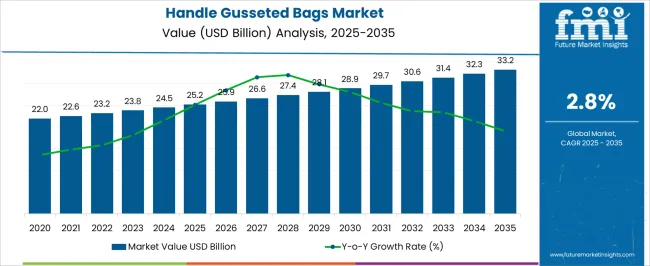
| Metric | Value |
|---|---|
| Handle Gusseted Bags Market Estimated Value in (2025 E) | USD 25.2 billion |
| Handle Gusseted Bags Market Forecast Value in (2035 F) | USD 33.2 billion |
| Forecast CAGR (2025 to 2035) | 2.8% |
The handle gusseted bags market is witnessing robust expansion, supported by the rising adoption of flexible packaging solutions across retail and institutional supply chains. Growing consumer emphasis on convenience, reusability, and storage efficiency has positioned gusseted bags as a preferred format for both end users and brands. These bags offer enhanced volumetric capacity due to side or bottom gussets, making them suitable for bulk packaging while maintaining structural integrity.
The integration of handles has improved portability, particularly in urban retail and food service settings where on-the-go consumption and multi-product carrying are prevalent. Shifting regulatory policies on single-use plastics and the ongoing push toward recyclable and biodegradable materials have further encouraged manufacturers to develop sustainable gusseted packaging formats.
The increased focus on visual merchandising and brand presentation has also contributed to the segment's growth, with custom print capabilities enhancing shelf appeal Over the coming years, rising demand from e-commerce, QSR chains, and specialty retailers is expected to further strengthen the market footprint across both developed and emerging regions.
The market is segmented by Closing Type, Raw Material Type, and End Use Industry and region. By Closing Type, the market is divided into Side Flat Bottom Gusseted Bags, Round Bottom Gusseted Bags, and Zipper Gusseted Bags. In terms of Raw Material Type, the market is classified into Polyethylene (PE), Plastic, Polypropylene (PP), Poly Vinyl Chloride (PVC), Others, Paper, and Aluminum. Based on End Use Industry, the market is segmented into Food & Beverages, Personal Care & Cosmetics, Pharmaceutical & Healthcare, and Others. Regionally, the market is classified into North America, Latin America, Western Europe, Eastern Europe, Balkan & Baltic Countries, Russia & Belarus, Central Asia, East Asia, South Asia & Pacific, and the Middle East & Africa.
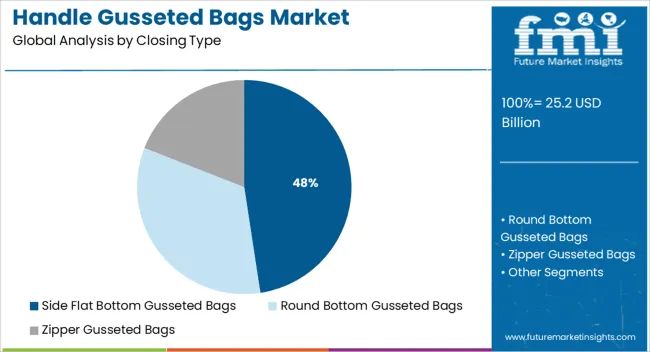
The side flat bottom gusseted bags segment is expected to account for 47.6% of the revenue share in the handle gusseted bags market in 2025, establishing itself as the leading closing type. The segment’s strong position is being driven by its ability to combine aesthetic appeal with superior load-bearing capacity. These bags offer a stable base that supports upright positioning, enhancing visibility on shelves and improving end-user convenience during storage and transportation.
Their structural design accommodates a larger fill volume without compromising shape or durability, making them ideal for retail packaging, takeaway services, and grocery chains. Compatibility with automated filling equipment and digital printing technologies has also boosted adoption, enabling greater operational efficiency and branding flexibility.
The enhanced barrier protection offered by multi-layered materials used in this format has reinforced its suitability for products requiring moisture and odor control The ease of handling provided by integrated handles, along with the secure sealing options, has further increased the appeal of side flat bottom gusseted bags among brand owners and packaging converters.
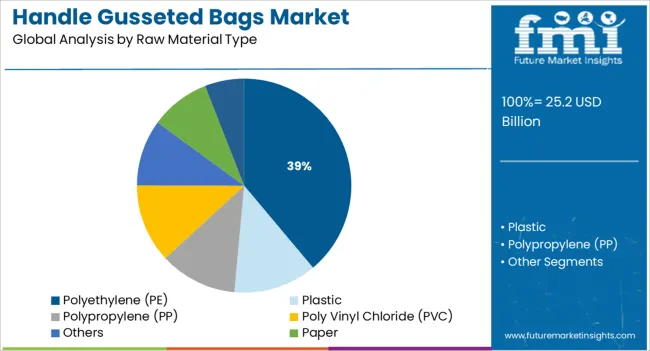
The polyethylene segment is anticipated to represent 38.9% of the handle gusseted bags market’s revenue share in 2025, driven by its versatility, cost-effectiveness, and ease of processing. PE has remained a preferred raw material due to its favorable mechanical properties including puncture resistance, flexibility, and compatibility with multiple forming and sealing techniques. Its ability to withstand various environmental conditions without compromising integrity makes it suitable for both food and non-food packaging.
The growing demand for recyclable and reusable packaging formats has further supported the continued use of polyethylene, especially with the emergence of mono-material solutions designed for easier recyclability. PE's compatibility with a wide range of printing and lamination techniques also allows high-resolution branding, which is increasingly important in consumer-focused industries.
Innovations in bio-based PE and advances in downgauging technologies have further enhanced the sustainability profile of the material, ensuring its relevance amidst tightening environmental regulations As packaging manufacturers strive to balance performance, cost, and environmental impact, polyethylene continues to be a material of strategic importance.
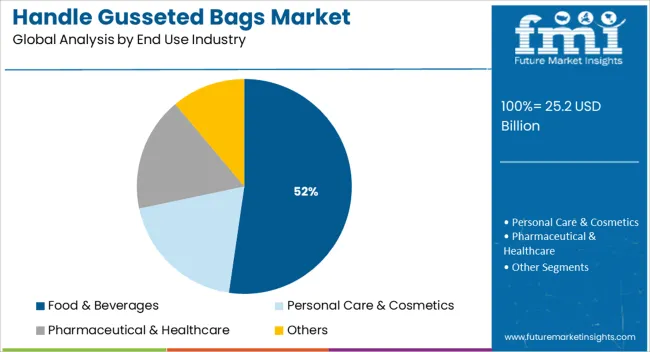
The food and beverages segment is projected to account for 52.3% of the total revenue share in the handle gusseted bags market by 2025, solidifying its position as the dominant end-use industry. This growth is being driven by the need for hygienic, portable, and visually appealing packaging solutions in both fresh and processed food categories. The ability of gusseted bags to provide enhanced shelf life through multi-layer barrier properties has made them highly suitable for dry snacks, bakery items, dairy, and frozen goods.
Their compatibility with resealable closures and ergonomic handles improves consumer convenience, especially in high-frequency use cases like takeaway meals and grocery shopping. The rise of modern retail formats and increasing demand for branded private label packaging have further accelerated adoption in the food and beverage industry.
Additionally, regulatory compliance with food safety standards and the ability to support high-quality printing for brand visibility have strengthened the position of handle gusseted bags in this sector The ongoing shift toward sustainable packaging materials and waste reduction targets continues to shape innovation and product development across food packaging applications.
Packaging protects our product from any kind of damage as well as it enables users to carry the product from one place to another place. It also restoring the freshness of the product and also provide the consumer with convenience in terms of storing the product. Handle Gusseted bags falls under the category of flexible packaging manufactured from various materials.
Handle gusseted bags are mostly used because of its eco-friendly nature and biodegradable. Handle gusseted bags are used by various shopkeepers and in the supermarket due to its low cost and are also easy to use. Earlier handle gusseted bags were used for packaging of tea and coffee only but now it is being used in various product portfolio.
Handle gusseted bags helps to stabilize the product and increases the product life and the freshness of the product. Handle gusseted bags are easier to carry and occupy less space. Handle Gusseted bags are being extensively used by various retailers and consumer good manufacturing companies. Handle gusseted bags are being used to enhance the brand images by promoting their company logo on their bags.
As compared to conventional gusseted bags, handle gusseted bags are ease to carry which are the key factors that enhance the growth of handle gusseted bags. Handle gusseted bags ensures the product safety and rawness of the product. The easy handling property and the light weight of handle gusseted bags are driving the growth of handle gusseted bags.
The high cost of the handle gusseted bags as compared to the traditional gusseted bags is restricting the growth of the market of handle gusseted bags. The property of recyclability and biodegradability of handle gusseted bags are driving the growth of handle gusseted bags market.
Handle gusseted bags are being used in different industries like pharmaceutical, food & beverages, Cosmetics & home care etc. Handle gusseted bags are also being used for branding promotions of various companies. As the plastic bags cause more pollution and are not easily recycled therefore the government banned the use of plastic bags due to which the demand for handle gusseted bags is increasing.
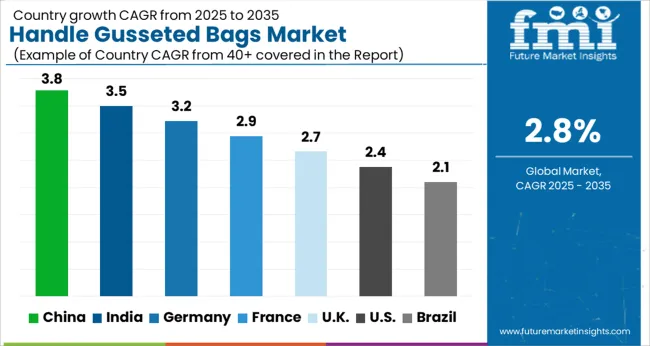
Geographically, the global Handle Gusseted Bags market is segmented into
Currently, Asia Pacific is leading the market owing to its large population base and high per capita consumption of gusseted bags as compared to Europe and North America. The demand of Handle Gusseted Bags is anticipated to rise in North America owing to the high-value features of the gusseted bags and an increasing demand from consumers for convenient and portable packaging.
The major key players of Handle Gusseted bags Market are, Uline, Inc., Pacific Bag, Inc., S. B. Packagings Ltd., International Plastics Inc., AR-BEE Transparent Products, Inc., CLEAR VIEW BAG COMPANY, Four Star Plastics, Inc, Elkay Plastics Co., Inc., The Bag Workshop, Novolex, etc.
Global handle gusseted bags market is being segmented on the basis of product type, raw material type and end use industry.
The global handle gusseted bags market is estimated to be valued at USD 25.2 billion in 2025.
The market size for the handle gusseted bags market is projected to reach USD 33.2 billion by 2035.
The handle gusseted bags market is expected to grow at a 2.8% CAGR between 2025 and 2035.
The key product types in handle gusseted bags market are side flat bottom gusseted bags, round bottom gusseted bags and zipper gusseted bags.
In terms of raw material type, polyethylene (pe) segment to command 38.9% share in the handle gusseted bags market in 2025.






Our Research Products

The "Full Research Suite" delivers actionable market intel, deep dives on markets or technologies, so clients act faster, cut risk, and unlock growth.

The Leaderboard benchmarks and ranks top vendors, classifying them as Established Leaders, Leading Challengers, or Disruptors & Challengers.

Locates where complements amplify value and substitutes erode it, forecasting net impact by horizon

We deliver granular, decision-grade intel: market sizing, 5-year forecasts, pricing, adoption, usage, revenue, and operational KPIs—plus competitor tracking, regulation, and value chains—across 60 countries broadly.

Spot the shifts before they hit your P&L. We track inflection points, adoption curves, pricing moves, and ecosystem plays to show where demand is heading, why it is changing, and what to do next across high-growth markets and disruptive tech

Real-time reads of user behavior. We track shifting priorities, perceptions of today’s and next-gen services, and provider experience, then pace how fast tech moves from trial to adoption, blending buyer, consumer, and channel inputs with social signals (#WhySwitch, #UX).

Partner with our analyst team to build a custom report designed around your business priorities. From analysing market trends to assessing competitors or crafting bespoke datasets, we tailor insights to your needs.
Supplier Intelligence
Discovery & Profiling
Capacity & Footprint
Performance & Risk
Compliance & Governance
Commercial Readiness
Who Supplies Whom
Scorecards & Shortlists
Playbooks & Docs
Category Intelligence
Definition & Scope
Demand & Use Cases
Cost Drivers
Market Structure
Supply Chain Map
Trade & Policy
Operating Norms
Deliverables
Buyer Intelligence
Account Basics
Spend & Scope
Procurement Model
Vendor Requirements
Terms & Policies
Entry Strategy
Pain Points & Triggers
Outputs
Pricing Analysis
Benchmarks
Trends
Should-Cost
Indexation
Landed Cost
Commercial Terms
Deliverables
Brand Analysis
Positioning & Value Prop
Share & Presence
Customer Evidence
Go-to-Market
Digital & Reputation
Compliance & Trust
KPIs & Gaps
Outputs
Full Research Suite comprises of:
Market outlook & trends analysis
Interviews & case studies
Strategic recommendations
Vendor profiles & capabilities analysis
5-year forecasts
8 regions and 60+ country-level data splits
Market segment data splits
12 months of continuous data updates
DELIVERED AS:
PDF EXCEL ONLINE
Market Share Breakdown of Handle Gusseted Bags Manufacturers
Loop Handle Bags Market Insights and Forecast 2025 to 2035
Twisted Handle Bags Market
Market Share Insights of Gusseted Bag Providers
Gusseted Bag Market by Material Type from 2024 to 2034
D-Handle Jigsaw Market Size and Share Forecast Outlook 2025 to 2035
Telehandler Market Size and Share Forecast Outlook 2025 to 2035
Polybags Market Size and Share Forecast Outlook 2025 to 2035
Net Bags Market
VCI Bags Market
Sandbags Market
Leno Bags Market Size and Share Forecast Outlook 2025 to 2035
Silo bags Market Size and Share Forecast Outlook 2025 to 2035
Food Bags Market Share, Size, and Trend Analysis for 2025 to 2035
Competitive Breakdown of Silo Bag Manufacturers
Paper Bags Market Size and Share Forecast Outlook 2025 to 2035
Jumbo Bags Market Size and Share Forecast Outlook 2025 to 2035
Blood Bags Market Size and Share Forecast Outlook 2025 to 2035
Craft Bags Market Growth, Trends, Forecast 2025 to 2035
Market Share Breakdown of Craft Bags Manufacturers

Thank you!
You will receive an email from our Business Development Manager. Please be sure to check your SPAM/JUNK folder too.
Chat With
MaRIA